
Cycloaddition Reactions in Organic Synthesis
.pdf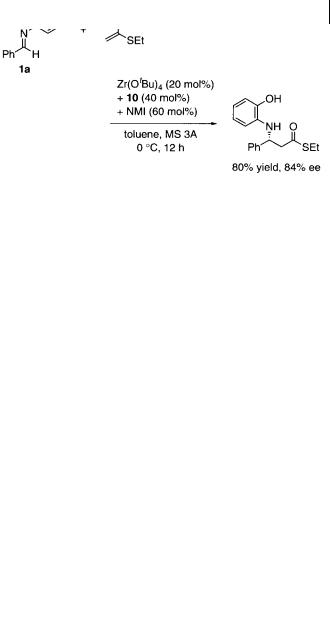
5.5 Chiral Catalyst Optimization 199
Scheme 5.6 Mannich-type reaction
The catalyst was divided into three parts (X, Y, Z in Scheme 5.7). First, to optimize Y, polymer-supported (R)-1,1 -binaphthol (BINOL) derivatives were prepared [26]. The synthetic route is shown in Scheme 5.8. 6-Tethered (R)-BINOL derivative 11 was readily prepared from BINOL [27]. After MOM protection (12), the ester moiety of 12 was reduced with lithium aluminum hydride (LiAlH4) to give 13, the hydroxyl group of which was protected as its tert-butyldimethylsilyl (TBS) ether (14). The 3,3 -positions of 14 were then brominated via an aromatic lithium intermediate to afford 15 and, after deprotection of the TBS ether (16), 1% divinylben- zene-cross-linked polystyrene (Merrifield resin) was used as a polymer support to form 17. A key step to introduce aryl substituents at the 3,3 -positions of 17 was performed using the Suzuki reaction with boronic acids under the influence of a palladium catalyst [28]. After deprotection of the MOM groups of 18 the desired polymer-supported BINOL derivatives (19) were obtained successfully. All the sol- id-phase reactions were monitored by 1H and 13C swollen-resin magic angle spinning (SR MAS) NMR [29].
Scheme 5.7
Polymer-supported BINOLs thus prepared were treated with Zr(Ot-Bu)4 to form polymer-supported zirconium 20. In the presence of 20 mol% of various zirconium 20, the model aza Diels-Alder reactions of imine 1d with Danishefsky’s diene (7a) were performed; results from selected examples are shown in Table 5.8. Whereas the 4-t-butylphenyl group resulted in lower enantiomeric excess (ee), higher ee were obtained when 3,5-xylyl, 4-biphenyl, 4-fluorophenyl, and 3-tri-

200 5 Catalytic Enantioselective Aza Diels-Alder Reactions
Scheme 5.8 Synthesis of polymer-supported BINOLs
fluoromethylphenyl groups were introduced at the 3,3 -positions of the BINOLs. Among these the 4-fluorophenyl and 3-trifluoromethylphenyl groups were the most promising in both yield and selectivity. One advantage using polymer-sup- ported BINOLs is that the ligand can be easily recovered by simple filtration and re-used. For example, in the reaction of 1d with 1-methoxy-2-methyl-3-trimethylsil- oxy-1,3-butadiene (7c) in the presence of 20 mol% 20a (Ar = 3-trifluoromethylphe- nyl); 1st run, > 99% yield, 91% ee; 2nd run, 97% yield, 90% ee; 3rd run, 97% yield, 90% ee. It is also noted that many chiral ligands were synthesized and optimized rapidly using the solid-phase methods.
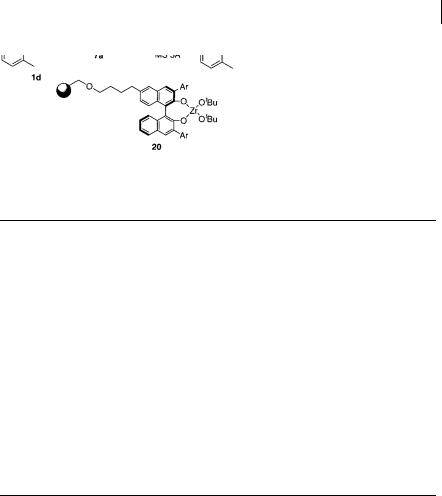
5.5 Chiral Catalyst Optimization 201
Tab. 5.8 Catalyst optimization using 20 in the reaction of 1d with 7a
Ar |
Yield (%) |
ee (%) |
|
|
|
|
|
Phenyl |
61 |
|
77 |
m-Tolyl |
80 |
|
73 |
o-Tolyl |
80 |
|
72 |
4-tert-Butylphenyl |
58 |
|
48 |
3,5-Xylyl |
70 |
|
82 |
4-Biphenyl |
59 |
|
80 |
2-Naphthyl |
74 |
|
74 |
6-Methoxy-2-naphthyl |
61 |
|
70 |
4-Fluorophenyl |
80 |
(78) a) |
83 (88) a) |
3,4-Difluorophenyl |
82 |
|
71 |
3-Trifluoromethylphenyl (20a) |
87 |
(> 99) a) |
80 (91) a) |
3,5-bis(Trifluoromethyl)phenyl |
92 |
|
60 |
3-Methoxyphenyl |
75 |
|
76 |
4-Methoxyphenyl |
75 |
|
41 |
3,4-Dimethoxyphenyl |
82 |
|
60 |
4-Ethoxyphenyl |
63 |
|
59 |
2-Thienyl |
61 |
|
44 |
a) 1-Methoxy-2-methyl-3-trimethysiloxy-1,3-butadiene (7c) was used instead of 7a
Next, the X and Z parts were optimized using liquid-phase methods. Several zirconium catalysts were prepared and were tested in the model reaction of 1d with 7a. The results are summarized in Table 5.9. Higher selectivity was obtained when electron-withdrawing cyano groups were introduced at the R4 positions. Higher selectivity was also observed when electron-withdrawing groups such as fluoro and trifluoromethyl groups were employed at the R2 and R3 positions. It was, in addition, revealed that slow addition of the substrates to the catalyst was effective. Finally, 94% ee of the aza Diels-Alder adduct was obtained when only 2 mol% of the catalyst (20f) was employed.
Several examples of catalytic asymmetric aza Diels-Alder reactions are shown in Table 5.10 [30]. The reaction always proceeded smoothly to afford the correspond-

202 5 Catalytic Enantioselective Aza Diels-Alder Reactions
Tab. 5.9 Catalyst optimization using 10 in the reaction of 1d with 7a
R1 |
R2 |
R3 |
R4 |
Amount catalyst |
Yield (%) |
ee (%) |
|
|
|
|
(mol%) |
|
|
|
|
|
|
|
|
|
H |
H |
H |
t-BuO (20a) |
20 |
92 |
77 |
Br |
H |
H |
t-BuO (20b) |
20 |
93 |
91 |
Br |
H |
H |
t-BuO (20b) |
10 |
81 |
77 |
Br |
H |
H |
t-BuO (20b) |
5 |
75 |
52 |
Br |
H |
H |
CN (20c) |
20 |
94 |
94 |
Br |
H |
H |
CN (20c) |
10 |
90 |
88 |
Br |
H |
H |
CN (20c) |
5 |
84 (92) a) |
68 (92) a) |
Br |
H |
H |
CN (20c) |
2 |
77 (83) a) |
47 (80) a) |
H |
F |
H |
CN (20d) |
2 |
59 |
73 |
Br |
F |
H |
CN (20e) |
2 |
70 (70) a) |
77 (85) a) |
H |
H |
CF3 |
CN (20f) |
2 |
73 (68) a) |
87 (94) a) |
Br |
H |
CF3 |
CN (20g) |
2 |
74 |
88 |
|
|
|
||||
a) A mixture of 1d and 7a was added to the catalyst over a period of 1 h |
|
|
||||
Tab. 5.10 |
Catalytic asymmetric aza Diels-Alder reactions |
|
|
|||
R1 |
R2 |
Amount catalyst |
Yield (%) |
ee (%) |
|
|
(mol %) |
|
|
|
|
|
|
|
Ph |
H |
5 |
76 |
92 |
Ph |
Me |
5 |
81 |
91 |
o-MePh |
H |
5 |
93 |
91 |
o-MePh |
H |
2 |
68 |
94 |
o-MePh |
H |
1 |
64 |
83 |
o-MePh |
Me |
2 |
72 |
88 |
-Nap |
H |
5 |
80 |
92 |
-Nap |
H |
2 |
67 |
86 |
-Nap |
Me |
2 |
71 |
84 |
|
H |
5 |
75 |
90 |
|
Me |
2 |
68 |
90 |
2-Thiophene |
H |
2 |
61 |
83 |
c-C6H11 |
Me |
5 |
75 |
84 a) |
|
|
|
|
|
a) The imine was prepared from cyclohexanecarboxaldehyde and 2-amino-3-methylphenol
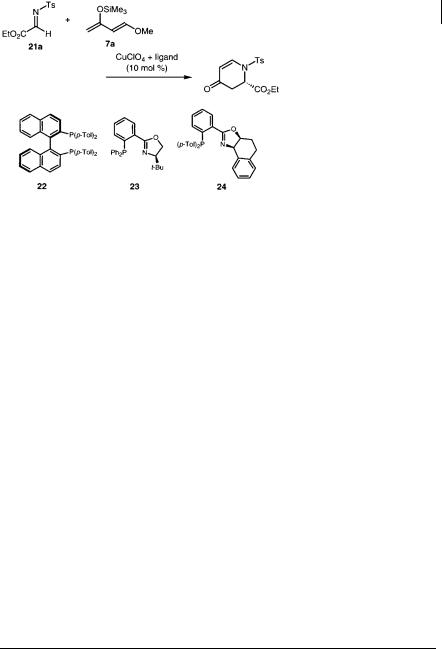
5.6 Aza Diels-Alder Reactions of -Imino Esters with Dienes 203
ing piperidine derivatives in good to high yields and high enantiomeric excess using 1–5 mol% of the chiral zirconium catalyst.
Thus, a novel chiral zirconium complex for asymmetric aza Diels-Alder reactions has been developed by efficient catalyst optimization using both solid-phase and liquid-phase approaches. High yields, high selectivity, and low loading of the catalyst have been achieved, and the effectiveness of chiral catalyst optimization using a combination of solid-phase and liquid-phase methods has been demonstrated.
5.6
Aza Diels-Alder Reactions of -Imino Esters with Dienes
-Imino esters (21a) are reactive electrophiles and dienophiles. It has been found that N-tosyl- -imino ester reacted with Danishefsky’s diene (7a) in the presence of a catalytic amount of a chiral Lewis acid to afford the corresponding aza Diels-Alder adduct in a highly stereoselective manner [31]. Several combinations of Lewis acids and chiral ligands were screened, and it was revealed that CuClO4 combined with Tol-BINAP (22) and phosphinooxazoline ligands (23 and 24) gave the highest enantioselectivity (Table 5.11). Although CuOTf and CuPF6 were available, other Lewis acids such as Zn(OTf)4, Cu(OTf)2, AbSbF6, AgOTf, AgClO4, Pd(SbF6)2, Pd(ClO4)2, Pd(OTf)2, and RuSbF6 resulted in significantly lower enantiomeric excess, even though good yields of the desire adducts were obtained by using these Lewis acids.
Tab. 5.11 Aza Diels-Alder reaction of -imino esters
Ligand |
Solvent |
Yield (%) |
ee (%) |
|
|
|
|
22 |
THF |
80 |
79 |
23 |
THF |
82 |
87 |
24 |
CH2Cl2 |
77 |
86 |
|
|
|
|
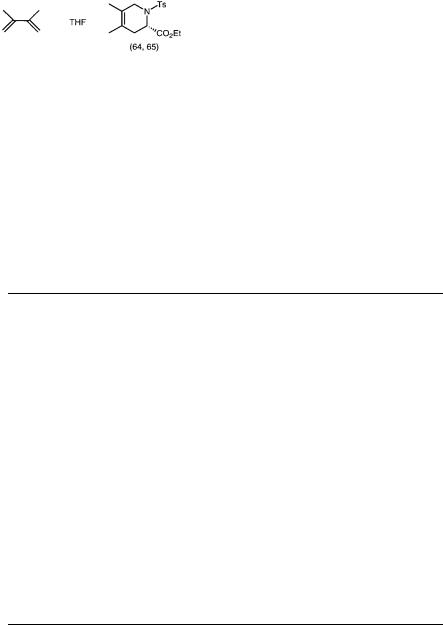
204 5 Catalytic Enantioselective Aza Diels-Alder Reactions
Several other dienes were then tested in chiral Cu-catalyzed aza Diels-Alder reactions (Table 5.12). When trans-1-methoxy-2-methyl-3-(trimethylsiloxy)-1,3-penta- diene was treated with -imino ester 21a in the presence of 10 mol% CuClO4-Tol- BINAP, the desired adduct was obtained in high yield with high diastereoand enantioselectivity (91% yield, trans/cis = 90/10, 94% ee (trans)). The reaction also proceeded smoothly even in the presence of 1 mol% of the catalyst (76% yield, trans/ cis = 92/8, 96% ee (trans)). It was noted that the exo-trans adduct was obtained preferentially. The reaction would proceeded via the E isomer of imine 21a and N-tosyl substituent adapting an endo orientation relative to the diene in the transition state to afford the exo adduct (Scheme 5.9). In addition, non-activated dienes such as cyclopentadiene, cyclohexadiene, and isoprene also reacted with -imino ester 21a to afford the aza Diels-Alder adducts in good to high yields with good enantiomeric excess. Although these dienes are known to be less reactive than Danishefsky’s diene (7a), they reacted smoothly in these chiral Cu-catalyzed reactions.
Tab. 5.12 Aza Diels-Alder reactions using several dienes
Dienophile |
Diene |
Solvent Major product |
|
|
(Yield, exo/endo, ee) |
|
|
|
For imines, -imino esters with an N-p-methoxyphenyl substituent (21b) also reacted with Danishefsky’s diene in the presence of 10 mol% of CuClO4-Tol-BINAP to give the corresponding adduct in high yield with good enantiomeric excess (Scheme 5.10). Remarkably, reverse enantioselectivity was observed when the - imino esters 21a and 21b were used. This notable selectivity was explained by as-

5.7 Aza Diels-Alder Reactions of 2-Azadienes 205
Scheme 5.9 Assumed transition state
Scheme 5.10 |
|
|
Scheme 5.11 Assumed coordination forms
suming tridentate and bidentate coordination, respectively, of the imines to copper (I), as shown in Scheme 5.11. The solvents, THF and CH2Cl2, might also affect the transition states and the selectivity.
A chiral magnesium catalyst prepared from magnesium iodide and 1,2-diphenyl- ethylenediamine was also found to be effective in asymmetric aza Diels-Alder reaction of -imino ester 21b with 7a (Scheme 5.12) [32]. The novel catalyst was discovered using parallel combinatorial methods.
5.7
Aza Diels-Alder Reactions of 2-Azadienes
In the presence of 10 mol% chiral Cu(II) catalyst 25, 2-azadienes 26 reacted with dienophiles 27 to afford the corresponding piperidone derivatives in high yields
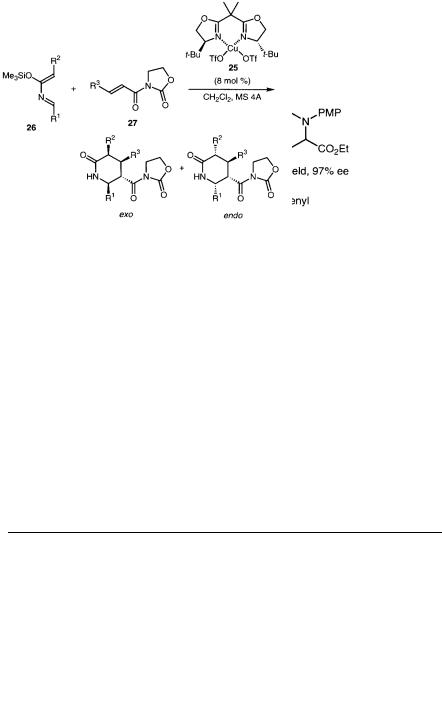
206 5 Catalytic Enantioselective Aza Diels-Alder Reactions
Scheme 5.12
Tab. 5.13 Catalytic asymmetric aza Diels-Alder reactions of 2-azadienes
R1 |
R2 |
R3 |
Temp. ( C) |
Yield (%) |
exo/endo |
ee (%) (exo) |
Ph |
Me |
Me |
–45 |
80 |
> 99 : 1 |
95 |
Ph |
Me |
Me |
Room temp. |
96 |
> 99 : 1 |
94 |
Ph |
H |
H |
–45 |
83 |
86 : 14 |
98 |
Ph |
Me |
H |
–45 |
96 |
> 99 : 1 |
98 |
Ph |
H |
Me |
Room temp. |
80 |
> 99 : 1 |
93 |
|
Me |
Me |
Room temp. |
98 |
> 99 : 1 |
90 |
Me |
Me |
–45 |
62 |
> 99 : 1 |
95 |
|
|
|
|
|
|

References 207
and high enantiomeric excess (Table 5.13) [33]. This reaction provides a useful route for the synthesis of optically active piperidine derivatives.
5.8
Perspective
Several examples of catalytic asymmetric aza Diels-Alder reactions have been surveyed. In the presence of catalytic amounts of chiral Lewis acids based on Yb, Zr, Cu, and Mg high yields and high diastereoand enantioselectivity have been achieved. Important to these successes was the choice of the metals of the chiral Lewis acids. These reactions will be used for the synthesis of biologically important nitrogen-containing compounds. On the other hand, activated dienophiles and/or activated dienes often have to be used in these reactions, and turnover numbers of the catalysis are not always sufficient. These problems will be addressed by designing more efficient chiral Lewis acids. Catalytic asymmetric intramolecular aza Diels-Alder reactions, which have not yet been achieved, would, moreover, provide a useful route to optically active complexed nitrogen-containing cyclic compounds.
References
[1](a) Waldmann, H. Synthesis 1994, 535;
(b)Tietze, L. F.; Kettschau, G. Top. Curr. Chem. 1997, 189, 1; (c) Weinreb, S. M., Comprehensive Organic Synthesis,
Trost, B. M.; Fleming, I.; Semmelhock, M. F., Eds., Pergamon Press: Oxford, 1991, vol. 5, Chapter 4, p 401; (d) Boger, D. L.; Weinreb, S. M., Hetero Diels-Alder Methodology in Organic Synthesis, Academic Press: San Diego, 1987, Chapter 2 and 9.
[2](a) Borrione, E.; Prato, M.; Scorrano, G.; Stiranello, M. J. Chem. Soc., Perkin Trans. 1989, 1, 2245; (b) Waldmann, H.; Braun, M.; Drager, M. Angew. Chem., Int. Ed. Engl. 1990, 29, 1468; (c) Bailey, P. D.; Londesbrough, D. J.; Hanoox.
T. C.; Heffernan, J. D.; Holmes, A. B. J. Chem. Soc., Chem. Commun. 1994, 2543;
(d)McFarlane, A. K.; Thomas, G.; Whiting, A. J. Chem. Soc., Perkin Trans.
1995, 1, 2803; (e) Kündig, E. P.; Xu, L. H.; Romanens, P.; Bernardinelli, G.
Synlett 1996, 270.
[3](a) Hattori, K.; Yamamoto, H. J.Org. Chem. 1992, 57, 3264; (b) Hattori, K.;
Yamamoto, H. Tetrahedron 1993, 49, 1749; (c) Ishihara, K.; Miyata, M.; Hattori, K.; Tada, T.; Yamamoto, H. J. Am. Chem. Soc. 1994, 116, 10520.
[4]Ishitani, H.; Kobayashi, S. Tetrahedron Lett. 1996, 37, 7357.
[5](a) Kobayashi, S.; Araki, M.; Ishitani, H.; Nagayama, S.; Hachiya, I. Synlett 1995, 233; (b) Kobayashi, S.; Ishitani, H.; Nagayama. S. Synthesis 1995, 1195;
(c)Kobayashi, S.; Ishitani, H.; Nagayama, S. Chem. Lett. 1995, 423.
[6](a) Kobayashi, S.; Hachiya, I.; Ishitani, H.; Araki, M. Tetrahedron Lett. 1993, 34, 4535; (b) Kobayashi, S.; Ishitani, H. J.
Am. Chem. Soc. 1994, 116, 4083; (c) Kobayashi, S.; Ishitani, H.; Hachiya, I.; Araki, M. Tetrahedron 1994, 50, 11623;
(d)Kobayashi, S.; Araki, M.; Hachiya, I. J. Org. Chem. 1994, 59. 3758.
[7](a) Thom, K. F. US Patent 3615169 (1971); CA 1972, 76, 5436a; (b) Forsberg, J. H.; Spaziano, V. T.; Balasubramanian, T. M.; Liu, G. K.; Kinsley, S. A.; Duckworth, C. A.; Poteruca, J. J.; Brown, P. S.; Miller, J. L. J. Org. Chem.

208 5 Catalytic Enantioselective Aza Diels-Alder Reactions
1987, 52, 1017; (c) Kobayashi, S. Synlett
1994, 689.
[8]For example, (a) Rauckman, B. S.; Tidwell, M. Y.; Johnson, J. V.; Roth, B. J. Med. Chem. 1989, 32, 1927; (b) Johnson,
J.V.; Rauckman, B. S.; Baccanari, D. P.; Roth, B. J. Med. Chem. 1989, 32, 1942;
(c) Ife, R. J.; Brown, T. H.; Keeling,
D.J.; Leach, C. A.; Meeson, M. L.; Parsons, M. E.; Reavill, D. R.; Theobald,
C.J.; Wiggall, K. J. J. Med. Chem. 1992, 35, 3413; (d) Sarges, R.; Gallagher, A.; Chambers, T. J.; Yeh, L.-A. J. Med. Chem. 1993, 36, 2828; (e) Mongin, F.; Fourquez, J.-M.; Rault, S.; Levacher, V.; Godard, A.; Trecourt, F.; Queguiner,
G.Tetrahedron Lett. 1995, 36, 8415.
[9]Kobayashi, S.; Ishitani, H.; Araki, M.; Hachiya, I. Tetrahedron Lett. 1994, 35, 6325.
[10](a) Kobayashi, S.; Hachiya, I.; Araki, M.; Ishitani, H. Tetrahedron Lett. 1993,
34, 3755; (b) Kobayashi, S. Eur. J. Org. Chem. 1999, 15.
[11](a) Kleinman, E. F., Comprehensive Organic Synthesis, Trost, B. M.; Fleming, I.,
Eds., Pergamon Press: Oxford, 1991, vol. 2, Chapter 4, p 893; (b) Comprehensive Organic Synthesis, Trost, B. M.; Fleming, I., Eds., Pergamon Press: Oxford, 1991, vol. 8, Chapter 1; (c) Sandlar, S. R.; Karo, W., Organic Functional Group Preparations, Academic Press: New York, 1968, Chapter 13.
[12](a) Ishitani, H.; Ueno, M.; Kobayashi,
S.J. Am. Chem. Soc. 1997, 119, 7153; (b)
Kobayashi, S.; Ishitani, H.; Ueno, M.
J. Am. Chem. Soc. 1998, 120, 431; (c)
Ishitani, H.; Ueno, M.; Kobayashi, S.
J. Am. Chem. Soc. 2000, 122, 8180.
[13]For the use of 6,6 -dibromo-1,1 -bi-2- naphthol, see, (a) Terada, M.; Motoyama, Y.; Mikami, K. Tetrahedron Lett. 1994,
35, 6693; (b) Sasai, H.; Tokunaga, T.; Watanabe, S.; Suzuki, T.; Itoh, N.; Shibasaki, M. J. Org. Chem. 1995, 60, 7388.
[14]Danishefsky, S.; Kitahara, T. J. Am. Chem. Soc. 1974, 96, 7807.
[15]Danishefsky, S.; Bednarski, M.; Izawa, T.; Maring, C. J. Org. Chem. 1984, 49, 2290.
[16]The solvents may influence the structure of the catalyst. See also, Tietze, L. F.; Saling, P. Chirality 1993, 5, 329.
[17]Titanium (IV)-1,1 -bi-2-naphthol complexes derived from Ti(Oi-Pr)4 were used in some asymmetric reactions. For example, (a) Aoki, S.; Mikami, K.; Terada, M.; Nakai, T. Tetrahedron 1993, 49, 1783;
(b)Costa, A. L.; Piazza, M. G.; Tagliavini, E.; Trombini, C.; Umani-Ronchi, A.
J. Am. Chem. Soc. 1993, 115, 7001.
[18]Kobayashi, S.; Komiyama, S.; Ishitani, H. Angew. Chem., Int. Ed. Engl. 1998, 37, 979.
[19](a) Clive, D. L. J.; Bergstra, R. J. J. Org. Chem. 1991, 56, 4976; (b) Sugawara, S.; Yamada, M.; Nakanishi, M. J. Pharm.
Soc. Jpn. 1951, 71, 1345.
[20](a) Ojima, I., Ed. Catalytic Asymmetric Synthesis; 2nd Ed., VCH: New York, 2000;
(b)Noyori, R. Asymmetric Catalysis in Organic Synthesis, John Wiley & Sons; New York, 1994; (c) Nógrádí, M. Stereoselective Synthesis, 2nd ed., VCH: New York, 1995.
[21]Syntheses of both enantiomers using the same chiral source, (a) Kobayashi, S.; Ishitani, H. J. Am. Chem. Soc. 1994,
116, 4083; (b) Yamada, T.; Imagawa, K.; Nagata, T.; Mukaiyama, T. Chem. Lett. 1992, 2231; (c) Desimori, G.; Faita, G.; Invernizzi, A.; Righetti, P. P. Tetrahedron 1997, 53, 7671; (d) Gothef, K. V.; Hazell, R. G.; Jørgensen, K. A. J. Org. Chem. 1998, 63, 5483.
[22]Syntheses of both enantiomers using similar ligands which have the same chirality, (a) Kobayashi, S.; Horibe, M.
J. Am. Chem. Soc. 1994, 116, 9805; (b)
Kobayashi, S.; Horibe, M. Chem. Eur. J.
1997, 3, 1472.
[23]Yamamoto et al. demonstrated the effect of 3,3 -silyl-substituted BINOL. (a) Maruoka, K.; Itoh, T.; Araki, Y.; Shirasaka, T.; Yamamoto, H. Bull. Chem. Soc. Jpn.
1988, 61, 2975; (b) Maruoka, K.; Itoh, T.; Shirasaka, T.; Yamamoto, H. J. Am. Chem. Soc. 1988, 110, 310; (c) Maruoka, K.; Concepcion, A. B.; Yamamoto, H.
Bull. Chem. Soc. Jpn. 1992, 65, 3501; (d)
Maruoka, K.; Hoshino, Y.; Shirasaka, T.; Yamamoto, H. Tetrahedron Lett. 1988,
29, 3967.
